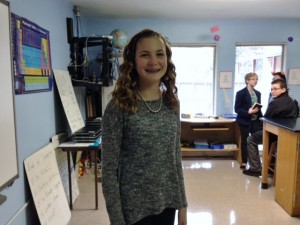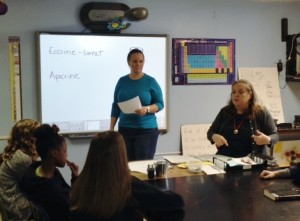Why Small Schools Might Be Better For Students Than Small Classes
The School of Arts and Sciences (SAS) in Tallahassee has just over 300 students, and the waiting list to get in is much longer.
Maureen Yoder is one of the founders of the 15-year-old K-8 charter school.
“We started this school with the intent of keeping it small because we want to create a school family,” Yoder says. “We believe that the relationship between the teacher and the students is the primary reason students succeed – besides a good home base.”
This is sixth grader Mary Stafford’s first year.
“I think I’ll stay. I didn’t want to at the beginning of the year. I wanted to go to a bigger school.”
Mary’s elementary school had 1,000 kids. Instead of moving on to a traditional middle school with her friends, her mom convinced her to try something different. “She liked the fact that it was small because you get one on one help, and she also liked all the teachers and their way of teaching.”
It’s been 12 years since Florida voters passed the class size amendment, limiting the number of students in certain classes, depending on the grade:
PreK – 3rd: 18
4th – 8th: 22
9th – 12th – 25
Now, an analysis by government watchdog Florida Taxwatch finds that small classes do make a difference in outcomes for kids in kindergarten through 3rd grade – but not in higher grades. The report’s author, Bob Nave, says the state is better off focusing on smaller schools, like SAS, rather than small classes.
“It’s fairly common sense that smaller classes should result in improved student performance,” Nave says. “The problem is the research just doesn’t back that up.”
The group compiled research showing students in smaller schools do better in math and reading, have fewer behavior problems, and participate in more extracurricular activities. They’re also more likely to graduate.
Nave says the state was actually on a path toward having smaller schools in 2000, when the Florida Legislature passed a law limiting the size of new schools under construction. Then, the class size amendment passed.
“The Legislature was forced not only to fund small schools, but now they had to fund small classes,” Nave says. “When one looks at the amount of money that was projected for school construction, it became clear that the Legislature could not do both.”
So lawmakers repealed the school size law to focus on class size.
Overall, the research on the effectiveness of small classes is mixed. “There are some studies that say yes, smaller classes do definitely improve academic outcomes, but there are other studies that show that it really has no effect at all,” says Kathleen McGrory, Miami Herald education reporter. “Here in Florida, we’ve seen slow and steady improvement in student test scores since 2002, but it’s really hard to draw any conclusions from that. The standards have changed; the tests have changed. So it’s really hard to make an apple to apples comparison.”
While the Taxwatch report says the state has nothing to show for its $30 billion investment in small class sizes, the state teacher’s union says the amendment hasn’t performed the way voters intended.
“If they would implement class size appropriately, we might see what it was meant to be,” says Joanne McCall, vice president of the Florida Education Association. “The Florida Legislature has decided that they would change things, and they eliminated a whole bunch of courses that would be affected by the class size.”

Gina Jordan/StateImpact Florida
6th grader Mary Stafford chose SAS for middle school. She's been told it'll take her a year to fully adjust to a school of 300 students, instead of the 1000 she's used to.
Districts that don’t comply with the limit in core classes have to pay a fine. But now, fewer classes are considered “core” classes. So, a science class like chemistry can have more students than classes like math or English.
Parents who want a small school for their kids are often limited to private or charter schools.
The Taxwatch analysis finds that Florida’s traditional public elementary and middle schools have the highest average enrollment in the country, and high school enrollment in Florida is almost twice the national average.
The small school formula has worked well for SAS – rated an “A” school for more than a decade. Many SAS employees are part-time, which allows the school to keep costs and enrollment down.
Technically, the school has larger elementary classes than the class size amendment allows. Even though it’s a charter school, Principal Julie Fredrickson says they do have to comply with the amendment.
“The way we meet it in elementary school is because we have two certified teachers in each classroom,” Fredrickson says. “For us, it isn’t just class size; it’s the way we’re teaching them. If you’re studying plants, then the plant is in there and you’re tearing the plant apart. So a small group can do that and get messy, and another group is doing research with the teacher. We can do those sorts of things.”

